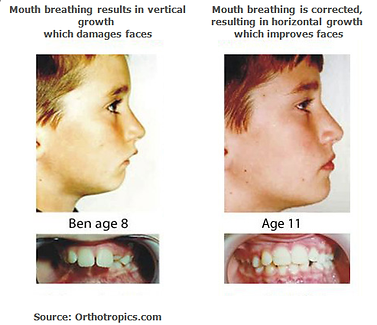Frequently
asked questions

What symptoms may indicate that I need Orofacial Myofunctional Therapy?
Children and Adults with OMD's may have some of the following associated symptoms:
-
Speech sound errors or distortions. Lisp at times when pronouncing ‘S’ sounds
-
Drooling
-
Tongue rests against your teeth
-
Chewing your food with your mouth open
-
Often mouth breath or your mouth sits open when relaxed
-
Misalignment of teeth
-
Teeth moved after orthodontia
-
High vaulted shape of the hard palate
-
Trouble breathing through the nose
-
Open mouth breathing (day or night)
-
Snoring or other sleep disorders
-
Allergies
-
Digestive problems such as reflux or stomach pain (may be caused by poor chewing and swallowing patterns)
-
Bloating after eating
-
TMJ (temporomandibular joint) Dysfunction or jaw popping, clicking, or pain
-
Frequent Headaches - "Migraines"
-
Neck pain, Stiffness
-
Facial pain
-
Ear ache, Tinnitus, Vertigo
-
Clenching or grinding of teeth (day or night)
-
Long Face syndrome, Imbalanced facial features, asymmetry of facial features
-
Forward posture of head/neck
-
Habits, including sucking of fingers, thumb, tongue, or cheek, prolonged use of a pacifier, chewing on clothing, excessive lip biting or licking, cheek biting, nail biting, chewing pens/pencils
-
Tongue thrust while swallowing (tongue come forward when you swallow)
-
Other chewing/swallowing problems
If any of the above sounds familiar, then do get in touch for a consultation.
What are Orofacial Myofunctional Disorders?
Orofacial Myofunctional disorders (OMDs) are incorrect muscle use and functions of the face and mouth - is when there is an abnormal mouth breathing, lip, jaw, or tongue position during rest, swallowing or speech.
OMDS may affect (directly and/or indirectly):
-
Breastfeeding
-
Facial skeletal growth and development
-
Chewing
-
Swallowing
-
Speech
-
Occlusion
-
Temporomandibular joint (TMJ) movement
-
Oral hygiene
-
Stability of orthodontic treatment
-
Facial aesthetics and more...

Understanding the causes of OMD's
The human body is a complex organism made up of many overlapping systems. When one of those systems has a glitch, pain and abnormalities can affect other bodily systems and make life more of a challenge.
What Causes Orofacial Myofunctional Disorders?
An amazing video explaining on patients develop crooked teeth, tongue thrust, and Temporomandibular disorder and how this can be prevented and treated.
Often mouth breathing is not evaluated and this video illustrates the importance of nasal breathing, proper tongue position, lip seal and swallowing - the main 4 Goals of Myofunctional Therapy .
How does Mouth Breathing Affect Childhood Development?
Craniofacial development is largest within the first 4 years of life, with 90% of development complete by 12 years of age. This proper formation is the beginning of healthy craniofacial development that can support lifelong nasal breathing. Improperly formed craniofacial features can be a strong indicator of risk for the development of obstructive sleep apnea. The principal nongenetic determinant of maxillary growth is the breathing route — nasal versus mouth breathing. Mouth breathing results in a narrow maxilla, high-arched palate, and increased lower facial height and facial esthetics. This craniofacial pattern has been termed the “long-face syndrome”. It is associated with obstructive sleep apnea (OSA) - a serious, debilitating, and potentially life-threatening sleep disorder, according to the National Sleep Foundation. Sleep apnea symptoms include mouth breathing at night, among other symptoms such as snoring, pauses in breathing while sleeping, difficulty getting up, behaviour problems, and tiredness during the day.
Does Mouth breathing harm a child’s physical development?
As time passes, mouth breathing shifts your child’s facial structures, potentially leading to:
-
Crooked teeth and overcrowding
-
Uneven face and jaw symmetry
-
Noticeable deformities
-
Overly visible gums
-
A narrow mouth
-
Persistent pain
Does Mouth breathing harm a child’s mental development?
When your child can’t breathe properly, their brain can’t function properly either. The result is:
-
Difficulties with concentration and problem solving
-
Development of sleep disorders like insomnia
-
Disrupted emotional and social development
-
Misdiagnosis of issues like ADD and ADHD
-
Slower cognitive development
-
Poor performance at school
The Diffrence between mouth breathing & nose breathing
Scientific reaserch has shown that mouth breathing (abnormal oral posture) can affect the normal development of the child face





